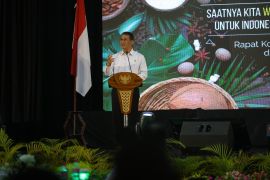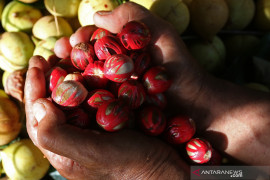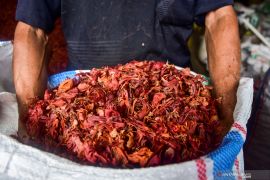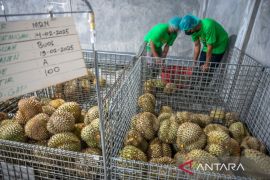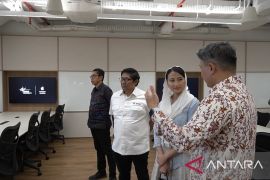Meanwhile, from the northern part of the Sulawesi Island, cloves and nutmeg are the main spices that are usually exported to the United States and the Netherlands.
Meanwhile, cloves, pepper, cinnamon, candlenut, and coriander are the main spices cultivated in the southern Sulawesi regions, especially Enrekang, Sinjai, Bone, and Bulukumba districts.
Descriptions of the potential of spices in the eastern regions of Indonesia illustrate the trail through which the nation's main commodities have achieved global fame.
In fact, Indonesia is seeking to get its spice route recognized as a world heritage by the United Nations Educational, Scientific and Cultural Organization (UNESCO) by 2024.
The fame of Indonesian spices had spread to foreign countries before the 5th century AD: as per Indian and Chinese chronicles, traders from a number of kingdoms in Indonesia dominated the trade of fragrant spices, comprising cloves and nutmeg.
It has been recorded that the Srivijaya Kingdom had come to rule the western and central region of the archipelago from the 8th to the 10th centuries by controlling all sea routes of the Western and Chinese nations to The Spices Islands, comprising the Malacca Strait route.
Meanwhile, in the eastern region, with the merging of the Gowa and Tallo kingdoms, an independent ruler of the spice route along the Selayar, Buton, Sula, and Maluku Islands emerged.
Related news: Preserve traditional herbal medicine: Jamu industry entrepreneur
Considering its past glory as well as to support the branding of the Indonesian Spice Route on the international stage, the Directorate of Cultural Development and Utilization at the Education, Culture, Research, and Technology Ministry has facilitated the Inventory of the Spice Route Sites, carried out by the Cultural Heritage Preservation Center of South Sulawesi province in November-December 2020.
The activity took place in the working areas of the preservation center which comprised the regions of South Sulawesi, West Sulawesi, and Southeast Sulawesi.
It began with a discussion regarding the Spice Route in South Sulawesi. Finally, four sites were determined according to their historical background, comprising Makassar and Parepare cities, as well as Gowa and Pinrang districts.
The head of the preservation center, Laode Muhammad Aksa, informed that within two months, the team conducted the activity by interlacing the toponym data from the Lontara ancient scripts with current modern conditions.
From the attempt, it was found that the spice routes in South Sulawesi were generally dominated by regions with highlands and cool air, such as in Enrekang, Sinjai and Gowa districts, as well as Parepare city.
Related news: Ministry unveils program for promoting Indonesian spices globally
Meanwhile, Makassar city, as the largest port in the eastern region of Indonesia, had an important role in connecting the archipelago's spice routes with foreign countries.
Nowadays, the spices exported from cultivation centers in South Sulawesi regions are more varied than before, head of the Industry and Trade Office of South Sulawesi, Ashari F Radjamilo, said.
He informed that, shipments of candlenut, cinnamon, and coriander to Europe are being sent via direct call export through the Soekarno Hatta Port Container Terminal, Makassar since April 12, 2021.
Earlier, export activities were carried out through the ports in Surabaya or Jakarta, he said.
However, after the central government issued a policy to permit state-owned port and logistic services provider PT Pelindo IV Makassar to export the commodities directly, there have been more opportunities for farmers and exporters to explore foreign markets and restore the past glory of Indonesian spices, he added.
Related news: Primeval roads charted by spice carriers
From exports to herbal medicines
The South Sulawesi provincial government has continued to encourage the region’s economic growth amid the COVID-19 pandemic, according to acting Governor of the province, Andi Sudirman Sulaiman.
One of the measures to achieve growth has been increasing the value of exports to foreign countries, including the export of spices, he said.
Although spices have not been able to surpass other commodities such as nickel, seaweed, cashews, cocoa, and fresh shrimp in terms of export volume and value, they have contributed to the rise of the value of exports of South Sulawesi province in the first quarter of 2021, he informed.
According to data from the South Sulawesi Provincial Central Bureau of Statistics, the value of the province's exports in the first quarter of 2021 reached Rp4.21 trillion, an increase of 19.15 percent year on year. Furthermore, an increase was also recorded in the following quarter.
It is proof that the provincial government has continued to assist in national economic recovery by encouraging an increase in exports, Sulaiman said.
Meanwhile, regarding the utilization of the spices, long before the arrival of the Europeans, the Chinese and Indians had first traced the spice route in the eastern regions of Indonesia.
Related news: Tracking the spice trail to Banda
At first, spices tended to be considered an aphrodisiac rather than seasoning. In addition, the ancient Greek philosopher Theophrastus (ca. 372-287 AD) had revealed that spices were used more by healers than cooks.
This is confirmed by a herbalist, Daeng Bani, from Makassar who has been using spices for more than 20 years to treat a number of diseases.
Bani -- who was also a host of the ‘Tambara' Gamasi’ program on a private radio station in Makassar – said that spices -- ranging from coriander, nutmeg to pepper -- were the main ingredients in herbal medicines and were always mixed with other herbal ingredients.
He said he often shared information on the use of spices as herbal medicine ingredients in his radio program as many listeners asked about them.
The herbalist said he is grateful as most listeners with health complaints had managed to recover with spice therapy.
Related news: Indonesian farmers should boost spice production akin to past: Jokowi
Specialist traditional healer of bones and nerves, H Salahuddin DM, from Makassar shared similar views on use of spices in herbal medicines.
He said he needs at least 10 types of spices to make his rubbing oil concoction for treating patients. Hence, the knowledge of spices and their use has to be preserved and passed on to the younger generations, he added.
Moreover, the spice trade in the past encouraged intercommunity and intercultural interactions between countries. This also influenced the development of the political and socio-cultural power of the Indonesian nation.
Hence, revitalizing the spice route is not only meant for the sake of history, but also for the benefit of current and future generations. Therefore, the Education, Culture, Research, and Technology Ministry's plan to make the Indonesian Spice Routes a cultural heritage recognized by UNESCO in 2024 should be supported.
Related news: Indonesia's forex reserves swells to US$144.8 billion in August
Related news: 23 districts, cities outside Java-Bali extend Level 4 PPKM: govt
Editor: Fardah Assegaf
Copyright © ANTARA 2021

